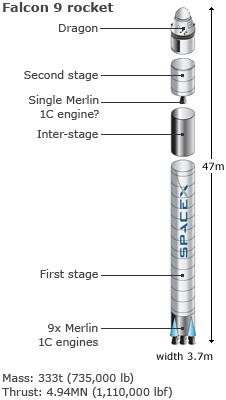SpaceX Falcon 9 rocket enjoys successful maiden flight
- Published
SpaceX's Falcon 9 rocket has enjoyed a successful maiden test flight after the first launch attempted was aborted.
The rocket, which could one day carry astronauts, blasted-off from its launch pad at Cape Canaveral, Florida, at 1845 GMT.
The California-based firm developed the vehicle with a large subsidy from Nasa.
Friday's first launch attempt was aborted at the last second because an engine parameter fell out of limits.
According to the Spaceflight Now website, a SpaceX spokesperson said the rocket achieved orbit, but they were not sure of the altitude or inclination.
US President Barack Obama, who inspected the rocket on its pad in April, has said he wanted the business of taxiing astronauts to and from the International Space Station handed to the commercial sector.
Many commentators believe the Falcon is in a prime position to win that business.
Before the rocket can be allowed to launch humans, it has to first demonstrate performance and reliability in the role of lofting robotic spacecraft.
Lofty ambitions
The Falcon 9 in its simplest form is a "single stick" vehicle with a two-stage configuration. A cluster of nine SpaceX-developed Merlin-1C engines will power the rocket off the pad.

A single Merlin on the second stage will complete the task of pushing the payload into orbit.
For its maiden flight, the Falcon 9 carried a cut-down version of its Dragon freighter - a blunt-nosed, 3.7m-wide capsule that will collect engineering performance data during the ascent.
On future flights, Dragon will be filled with supplies for the International Space Station.
Historically, the maiden flights of rockets have a notoriously high failure rate. Some two-thirds of the rockets introduced in the past 20 years have had an unsuccessful first outing.
Millionaire Elon Musk set up SpaceX in 2002 and has already flown a much smaller rocket called the Falcon 1.
To keep costs as low as possible, the Falcon 9 uses many of the same components and systems, including its kerosene/liquid-oxygen-burning Merlin engines.
SpaceX was awarded a $1.6bn contract by Nasa in 2008 for up to 12 Falcon/Dragon missions to the ISS.
The Dragon freighter, once operational, is expected to be capable of hauling six tonnes of food, water, air and equipment to the platform.
The company says it has designed Dragon in such a way that it can be converted relatively easily into a crew ship, if Nasa so desires it.
The company claims that it would be ready to launch astronauts on the Falcon within three years of being given an ISS taxiing contract.
However, other space companies and their rockets will almost certainly be in competition for such work, including some of the established industry names like Boeing and Lockheed Martin.
SpaceX hopes the Falcon 9 can also take a sizeable share of the commercial satellite launch market.
It is quoting prices to put large telecommunications spacecraft in geostationary orbit that dramatically undercut current sector leaders, such as Europe's Ariane 5 and Russia's Proton vehicles.
But Rachel Villain from the respected space analysts Euroconsult said many in the satellite business were being cautious about SpaceX's future prospects.
"This is not new in the industry," she told BBC News.
"When we had the maiden flight of Ariane 4, when we had the maiden flight of Atlas 3, the maiden flight of Delta 4 - all these vehicles promoted a good price for the company taking the risk of being on an early launch. I, like many in the industry, am watching to see if SpaceX can sustain these prices."